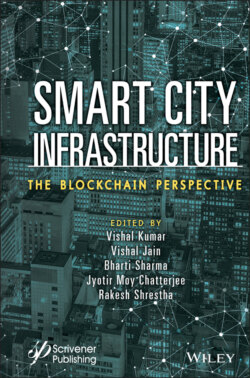Читать книгу Smart City Infrastructure - Группа авторов - Страница 17
1.2.3 Blockchain Elements
ОглавлениеBlockchain collects different techniques like mathematical methods, algorithms, cryptography protocols, and economic standards. It merges every part of end-to-end networking plus distributed consensus algorithm to resolve the management issues from a long-established scattered database. As we mentioned earlier, blockchain contains numerous elements; out of them here, we discussed some important points below [4–10, 12–18].
1 i. Decentralization: Decentralization can distribute functions and controls from a centralized authority to every entity that is associated. In the blockchain, each blockchain client provides a replica of the transaction record; moreover, a new block is implanted for the justification of transaction by the clients who are part of the blockchain structure.
2 ii. Consensus model: The inclusion of consensus models supports maintaining the purity of data recorded on the blockchain. In general, a consensus protocol contains three possessions; depend on applicability and good organization. Those are fault tolerance—a consensus procedure offers resilience while reviving to a failure not contributing to consensus. Safety—It must be safe and sound, reliable, and every node must produce a similar output legally binding under the protocol regulations; Liveness—Protocol must assure every non-faulty node to yield a value.
3 iii. Transparent: For explicit transactions, a blockchain scheme after a specific time (depend on application) verifies itself to make self-audit the eco-system of a digital price that resolves communications that occur in specifically mentioned time breaks. In a blockchain, the collected works of these transactions are acknowledged as block. As a result, it shows the intelligibility and incapability of frauds are engendered.
4 iv. Open source: As a decentralized structure blockchain kind, closed-source appliance trust that the appliance is purely working as decentralized then data not be contacted from a central basis. Blockchain-based locked appliances act as a hurdle to approval by customers. However, revulsion to a locked network was not traceable when the appliance plan to collect, hold and transmit customer endowments. Opensourcing, a distributed appliance, alters the formation of business performances who utilized to support the Internet as the general denominator.
5 v. Identity and access: In any network, identity and access are the two central pillars to succeed. Like in a blockchain, identity and access are associated with three major public, private, and consortium standards. A public or permission less blockchain proposed to eliminate the middleman at the same time maintains the security high. Private or permission blockchain restricts the customers from holding authority and justification of blockchain restrictions while creating smart contracts. The proposal designed for private blockchain endows with the effectiveness and seclusion of transactions. Last, consortium blockchain, moderately private, also allows a few determined discriminating nodes to have complete control.
6 vi. Autonomy: The central part of a blockchain is to exchange the trust from one authority to another authority exclusive of any indication. Every entity of the blockchain arrangement securely updates and transmits information. The transaction trace plus smart contract particulars are kept as blocks in the blockchain.
7 vii. Immutability: In any financial transaction, immutability is one of the major elements, which means unchanged over time. Just once, any kind of info noted in a block of the blockchain never alters after record. This will extremely helpful for data auditing, easily prove that the data is safe and sound, proficient, and not interfere or distorted. Moreover, in the recipient end, data is confident, genuine, and untouched.
8 viii. Anonymity: Anonymity is an entity in the blockchain address of a miner that is indispensable for this aspect, and no other aspect is requisite; consequential in anonymity determine trust-related concerns. In a communication structure, the anonymity set can be alienated into two sets: the dispatcher then the receiver.
